- Apply
- Visit
- Request Info
- Give
Eastern alumni teach with caring and dedication during pandemic
Written by Ed Osborn
Published on March 03, 2021
Since the COVID-19 pandemic began a year ago, more than three million schoolteachers across the nation — from preschool to high school — pivoted to online learning in spring 2020 and then came back to school in the fall to teach in person. Several Eastern Connecticut State University alumni told EASTERN Magazine of their teaching experiences.
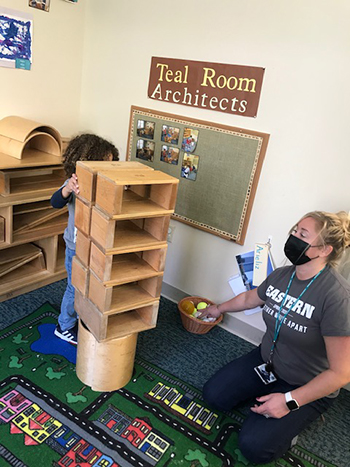
After remote teaching for the spring 2020 semester, teachers and children at Eastern’s on-campus Child and Family Development Resource Center (CFDRC) were happy to be reunited on ground this past fall, despite the pandemic. “Everyone is much quicker to adapt than we thought we could be,” said Heather (Oski) Standish ’15. “What surprised me most was how great relationships with families are despite not seeing them as much. Capturing photos to send daily and use in portfolios has reminded me just how important play is — children do amazing things if you just watch!”
“The greatest reward to teaching in person is the ability to form a trusting and caring relationship with children and their families,” said Leisha (Russell) Flynn ’19. “Teaching during COVID has also proven to be a true testament to the resiliency of young children. They wear their masks and they wash their hands so many times a day without skipping a beat.”
“Teaching during COVID has been a challenge if only just for the logistics — we balance sanitizing and teaching throughout the day,” said Patricia (Gardner) McCarthy ’05. “I miss seeing their whole faces, and I miss the children being able to read my facial expressions as well. We have become very adept at communicating smiles and joy in other ways. I intentionally smile all the way up to my eyes all the time now, in addition to doing thumbs up, and making a heart with my hands.”
Alan Reichle ’11 teaches special education at John J. Moriarty Elementary School in Norwich. He has been at the school for three years, previously teaching in New London, Montville and Windsor Locks. Like most schools across the country, Moriarty School closed down in March due to the COVID-19 pandemic and transitioned to online coursework by mid-April.
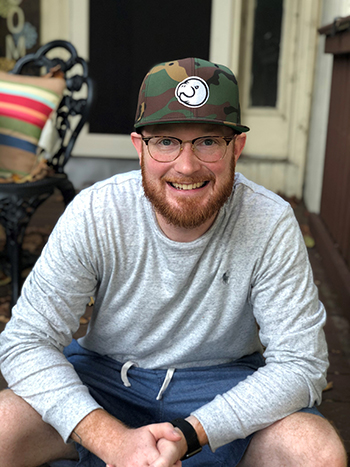
This fall Reichle worked with a cohort of 16 first- and second-grade students, with the children coming to school four days a week. “We closed for two weeks in October due to a spike, with the teachers continuing to come to school to deliver online instruction,” he explained. Since early November, students have been back at school receiving on-ground instruction. The new “normal” has meant Reichle has learned new technologies and teaching techniques, including using Google Suite for meetings, document sharing and other functions, embedding questions within PowerPoint, as well as using the “SeeSaw” classroom app and Zoom. “My principals have been great in planning the year and supporting our teachers.”
“I have really enjoyed the strong connection we have with our families,” continued Reichle, who has had some of his students since they were in kindergarten two years ago. With frequent cell phone conversations and the use of “Class Dojo,” another classroom app that connects teachers, students and parents, Reichle has learned “another side of the families.” During the pandemic, he has found that families feel isolated at home and sharing those challenges has come with tearful moments. “The bond I have with my families is amazing.”
Class Dojo allows Reichle to share daily activities in real time with parents — “this is what we did today” — and gives students another way to use technology to stay connected. Reichle also takes time to talk to his young charges about their feelings. “The other day we talked about Christmas and the reality that they won’t be seeing many relatives this season. They shared their sadness, and I told them I was also sad about the social distancing we all must follow. We had a little cry together, and knowing we were sharing the same experience helped them realize we will all be okay through this.”
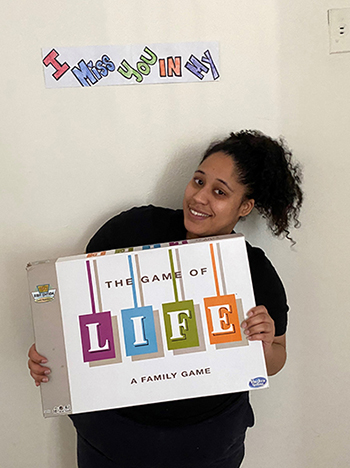
Jasmine Stakley ’12 teaches English at Brooklyn Preparatory High School in New York City. In addition to her teaching duties, she is the department head and leads weekly meetings. “In March, my role as a teacher suddenly switched from playful relationships, lively discussions and group poster projects to black screens and silence. My students became distant, and due to the lack of in-person interaction, our relationships suffered. Meanwhile, I would look out my window to see a city that supposedly never sleeps now slowly dying. The shops were closed, restaurants were boarded up and my students were trapped at home where I couldn’t reach them beyond my screen. It became hard to know which student needed me more as I was spread thin and pulled in many different directions.”
When schools reopened in the fall, Stakley stayed home. “Due to my asthma, I was fully remote from the beginning of the year, unlike many of my colleagues who went back to the building. Even though I wasn’t physically present, I still carried a lot of responsibility as the department lead, organizing and leading meetings twice a week.”
In spite of her health challenges, the feelings of isolation her students have experienced, and the reality that New York City has been hit hard by COVID-19, Stakley has maintained a positive attitude. “Since the beginning of the shutdown, more than eight months have passed, and it is December. We are looking forward to a promising new year, a new vaccine and a new president.
“Despite the daunting mandates and the millions of unanswered questions, some personal good has come from this year. I was fortunate enough to enjoy time at home with my boyfriend and my dog. I’ve had the opportunity to test out new recipes and become a plant mom. I settled into a new normal while taking every opportunity to speak with my students about deeper issues like racial injustice and family life. I’ve especially been more intentional about how I spend my time with loved ones. Most importantly, I am even more thoughtful about taking time for myself in a way I have never done before.”
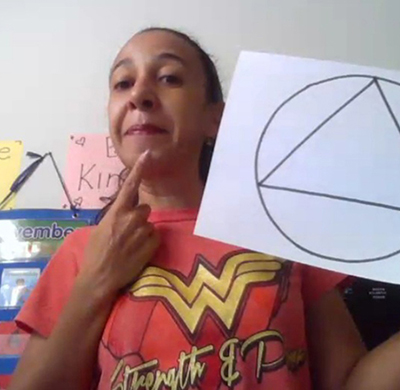
Ana Carolina Fernandes ’14 returned to her homeland of Brazil in 2015 after receiving her M.S. in Early Childhood Education. Since then she has been working in an American School in Belo Horizonte-Minas Gerais where she teaches three-and four-year-olds. After the school closed on March 17 due to COVID-19, “I was truly desperate! We had a short time to adjust our curriculum to online for my little ones. We are getting used to it and so are the students and the parents.”
During the fall semester, Fernandes used Zoom for meetings and posted activities to Seesaw. “My little ones usually need support from an adult or older sibling on how to use all the devices and platforms. We did it as a team — parents, teachers and children! During the semester, we reinvented ourselves as teachers and recreated our classroom. We had online birthday parties and online games. Our students developed many new abilities and mastered others.”
Fernandes credits Eastern and its focus on educational technology for preparing her for this experience. “I loved my program — it was one of the best experiences in my life.”
Jennifer (Royals) Frankel ’10 described her unique experience at Alphabet Academy — four Reggio Emilia-inspired early learning centers in the greater New Haven area. “This past summer, school districts, teachers and families grappled with the decision of whether or not in-person learning was a safe choice. Our executive director proposed an incredible solution, to expand our existing kindergarten program to three classrooms and spend as much of the day outdoors as possible. I was offered the chance to be the teacher of one of those classrooms.
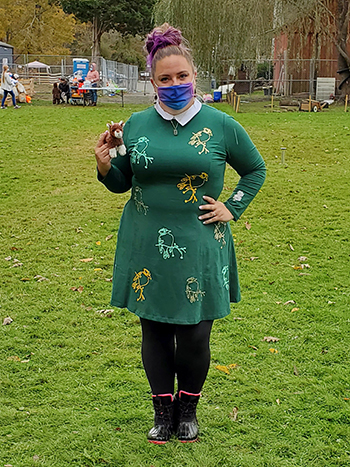
“During the 1918 Spanish Influenza pandemic, open-air schools popped up to combat the spread of the illness in cramped classrooms. Why couldn’t we do the same thing? On Sept. 1, I set up a learning space in the middle of a sunny field and welcomed five wide-eyed kindergarteners whose families had taken a leap of faith at this unconventional idea.
“Setbacks have been plentiful — a tornado three days before the start of the year; sweltering September weeks; a soggy October and the learning curve of how to keep paper from always being damp. Not to mention a mischievous raccoon who completely decimated a harvest display.
“My students were not just learning their letters. They got firsthand experience in differentiating between hot weather and temperatures better described as comfortable. They teamed up and created tools to clear leafy debris out of a creek bed so a stream could form. They shrugged their shoulders, comforting each other and even me when that raccoon ruined our first attempt at bird feeders.
“As December and cold weather approaches, our time spent inside is increasing but outdoor time remains an integral part of our day. My students currently are collecting branches to make kid-sized stick nests like the ones that ospreys make. I go home every day sunburned, muddy, wet or chilled. But the payoff? As of writing this, we have had zero cases of COVID-19 across four schools since our reopening in June. Additionally, in 58 days of school, only one of my students has stayed home for a single day due to illness. I look forward to the day when COVID-19 is past us, not because I want things to go back to the way they were. I just want my students to be able to see the smile they put on my face each day we spend outside.


